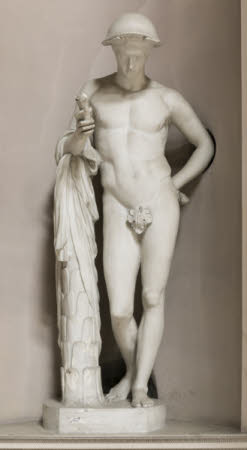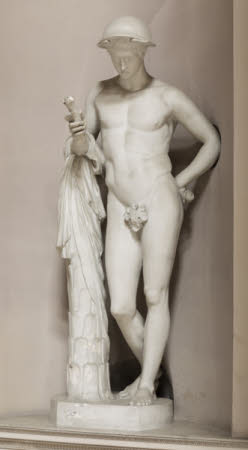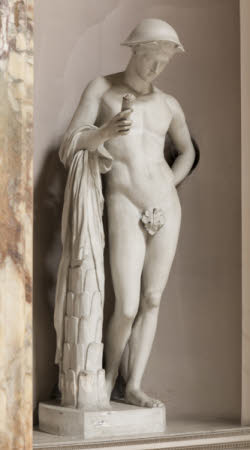The Bateman Mercury
Richard Hayward (Bulkington 1728 – London 1800)
Category
Art / Sculpture
Date
1757 - 1758
Materials
Painted plaster
Measurements
1770 x 800 mm
Place of origin
London
Order this imageCollection
Kedleston Hall, Derbyshire
NT 109012
Summary
Painted plaster, the Bateman Mercury, cast or acquired by Richard Hayward (Bulkington 1728–London 1800), 1757-58. A full-size plaster cast of a 2nd century Roman statue of Mercury formerly in the collection of William Bateman, 1st Viscount Bateman (1695-1744), now in the Los Angeles County Museum of Art (William Randolph Hearst Collection 48.24.15). Mercury, messenger of the gods, as a young man, nude, in contrapposto, wearing a winged petasus. His proper left arm bent at a right angle behind his back and his proper right arm leaning against a palm trunk. A traveler's cloak is draped over his proper right arm and over the palm. He holds a scroll, presumably containing a message, in his right hand.
Full description
The Bateman Mercury is rather an anomaly in the Kedleston cast collection as it was the only cast to have been supplied by the sculptor-mason Richard Hayward (1728-1800), the others having been supplied by Joseph Wilton and Matthew Brettingham, and it was the only cast to have been made from an antiquity in a British private collection, the others having been cast from celebrated marbles in Florence and Rome. It is one of two known plaster casts by Hayward of a 2nd-century Roman marble statue of Mercury, a copy of a lost Greek figure, acquired by William Bateman, first Viscount Bateman (1695-1744) of Shobdon Court (Vermeule and Bothmer 1956, p. 342). Praised by the antiquary Charles Townley, Bateman's Mercury was purchased by the newspaper magnate William Randolph Hearst and bequeathed to the Los Angeles County Museum in 1948 (LACMA inv.no. 48.24.15). A second plaster cast was recorded in the Duke of Richmond's Gallery and later lead versions came from the workshop of John Cheere, Sir Henry's brother (Kenworthy-Browne 1993, p. 252). Richard Hayward was for many years the apprentice and employee of Britain's great monumental sculptor Sir Henry Cheere (1703-81). He is perhaps best known for compiling a list of British visitors and Grand Tourists to Rome, which he began on his arrival to the city in June 1753 and which he continued to update via his network of contacts over the next twenty years. Returning to London in April 1754, Hayward ran a successful workshop of his own from premises in Piccadilly, producing sculptures, chimneypieces and reliefs. His workshop neighboured that of sculptor John Cheere, brother of Sir Henry and supplier of the lead statuary at Kedleston (see NT 108726.1-NT 108726.4, NT 108712.1, NT 108712.2). An exhibiting member of the Society of Artists, Hayward also produced architectural sculpture for Robert Adam (architect of Kedleston Hall), Sir William Chambers and James Paine. He was a regular buyer at sculptors' auctions and preserved for posterity the sales catalogues he consulted, today held at the British Museum. A receipted bill in the Kedleston Archive shows that on 23 January 1758 Nathaniel Curzon (1726-1804) paid Hayward £8 for a 'Statue of Mercury in Plaster of Paris’. It was displayed in the Marble Hall where it has remained ever since (see list of 'Hall Statues' including 'Mercury' in 'List of Statues I have', c. 1760, MS, Kedleston Archive). Alice Rylance-Watson 2019
Provenance
Purchased by Nathaniel Curzon, 1st Baron Scarsdale (1726-1804) from Richard Hayward (1728-1800); see receipted bill dated 23 January 1758 ‘to a Statue of Mercury in Plaster of Paris’ at £8-0-0 (MS, Kedleston Archive); identifiable in ‘List of Statues I have’ written by Nathaniel Curzon (1726-1804) c. 1760, as ‘Bateman’s Mercury’ and identifiable overleaf within a list of ‘Hall Statues’ (MS, Kedleston Archive); identifiable in the 'Catalogue of the pictures, statues, &c. at Kedleston' of 1769, within a handwritten list of ‘Hall’ statues (p.7; see annotated copy in the Getty Research Institute, Los Angeles); identifiable in ‘Catalogue’ of 1861 (Marble Hall, p. 7); purchased with part of the contents of Kedleston with the aid of the National Heritage Memorial Fund in 1987 when the house and park were given to the National Trust by Francis Curzon, 3rd Viscount Scarsdale (1924-2000).
Credit line
Kedleston Hall, The Scarsdale Collection (acquired with the help of the National Heritage Memorial Fund and transferred to The National Trust in 1987)
Makers and roles
Richard Hayward (Bulkington 1728 – London 1800) , sculptor
References
Vermeule, 1956: Cornelius C. Vermeule, and Dietrich vaon Bothmer, ‘Notes on a New Edition of Michaelis: Ancient Marbles in Great Britain’, American Journal of Archeology, vol.60 (1956), II, p. 342. Kenworthy-Browne 1993: John Kenworthy-Browne, ‘Designing around the statues. Matthew Brettingham’s casts at Kedleston’, Apollo, April 1993, pp.248-252, pp. 251-2.






